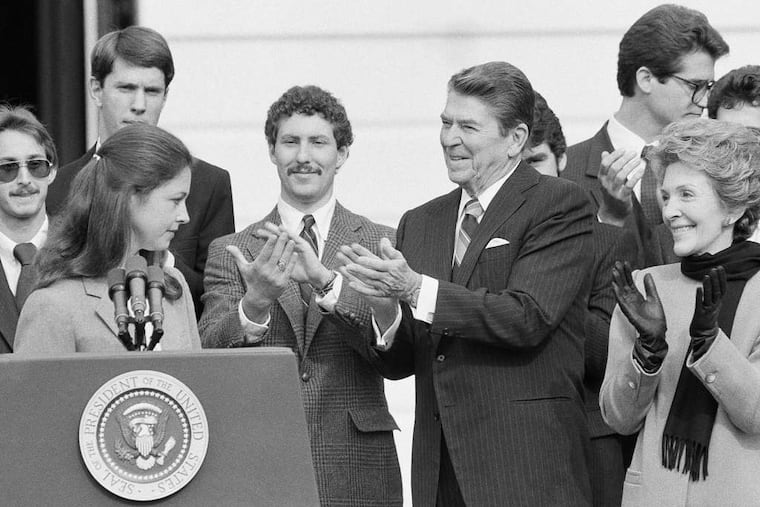'We are going!': Reagan was right about Grenada
Thirty years ago, on Oct. 25, 1983, the United States launched an invasion of Grenada, an island in the eastern Caribbean. This was the first major operation conducted by the U.S. military since the end of the Vietnam War, and it marked a new assertivenes

Thirty years ago, on Oct. 25, 1983, the United States launched an invasion of Grenada, an island in the eastern Caribbean. This was the first major operation conducted by the U.S. military since the end of the Vietnam War, and it marked a new assertiveness on the part of the United States. The objective was the liberation of Grenada, including the rescue of nearly 1,000 mostly American citizens who were attending the medical school at St. George's University.
Grenada had gained its independence from Britain in 1974, but in the years after had been subjected to active subversion by the Soviet Union and Cuba. In 1979, a leftist group called the New Jewel Movement seized power and set up a Marxist government. Within weeks, the new government had begun to receive arms shipments from Cuba and the Soviet Union, and the second communist takeover of an island in the Caribbean was soon complete.
Four years later, an internal power struggle broke out and Grenada was again involved in a bloody coup. The prime minister was murdered, along with 50 others. The People's Revolutionary Army announced a four-day curfew and confined the medical students to their quarters, with orders to shoot on sight anyone violating the curfew.
There was a very real concern within the Reagan national security team that the Marxist leaders in Grenada were considering taking American citizens as hostages, as had been done in Iran in 1979. Members of the National Security Council staff began planning a rescue operation. Some of the president's senior staff also began work on a plan to restore democracy, using an international security force that would include troops from other Caribbean nations.
In the week before the invasion, multiple interagency meetings were held, with serious debate on the pros and cons of an invasion. By Oct. 20, however, it seemed clear that Reagan had decided to strike a blow against the rising subversion across the Caribbean sponsored by the Soviet Union and its ally Cuba. It was also clear that the president wasn't about to let American citizens be taken hostage on his watch.
The final decision came on Sunday, Oct. 23, and the military received its orders.
What has not been widely known is that there was initially a good deal of resistance to the idea of a military intervention in Grenada at the senior levels of the State Department and the Pentagon. Secretary of State George Shultz; Defense Secretary Caspar Weinberger; Gen. John Vessey, the chairman of the Joint Chiefs; and their staffs all had expressed reluctance regarding a direct military option.
However, over the course of several high-level meetings, Reagan made clear that he was in favor of sending U.S. forces to rescue the American medical students and to restore a democratic government to Grenada. I had the good fortune to be in the room when Reagan simply said: "There are Americans there and they are in danger. We are going!" (His decision was documented in National Security Decision Directive 110A.)
Nearly 8,000 soldiers, sailors, airmen, and Marines participated in Operation Urgent Fury, along with 353 Caribbean soldiers from the Caribbean Peace Force. U.S. forces met with significant resistance from the Cuban Special Forces and from some elements of the Grenadian army. The U.S. Army Rangers' assault on the Point Salinas airfield encountered especially heavy resistance, and taking the airfield required support from the AC-130 gunships from the Air Force's 16th Special Operations Wing from Hurlbert Field, Fla.
Thirty years later, most Americans have forgotten those very dangerous times, but it is important to remember that numerous countries had been subverted to communism during the 1970s. The Soviet Union and its proxies, including East Germany and Cuba, had many successes, including in Angola, Mozambique, Ethiopia, Surinam, and Nicaragua.
It was, however, in Reagan's first term that the tide of Soviet aggression and subversion in the Western Hemisphere began to be reversed. In 1983 alone, two communist takeovers in Latin America were thwarted - Grenada, which received a great deal of public attention, and Surinam, where the Reagan administration implemented a secret and indirect intervention using the Brazilian government. Details of that secret effort have come to light only in the last few years.
Reagan and his national security team were also successful in preventing a Marxist takeover of El Salvador and helped end the tyranny of the Sandinista government in Nicaragua. These efforts, combined with Reagan's steady modernization and rebuilding of America's military strength in the 1980s, helped to bring an end to the Cold War.
Near the end of Reagan's second term, in a speech delivered at the Republican convention in New Orleans, he declared proudly that, in the 2,765 days of his administration, "not one inch of ground has fallen to the communists."
Given those achievements, it is worth reminding Americans, 30 years after the invasion, that Reagan's national security strategy of "peace through strength" and his courageous decision to liberate Grenada have paid real dividends even to this day.